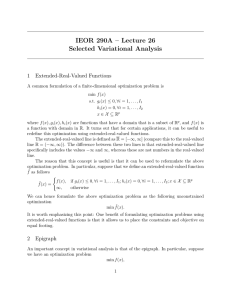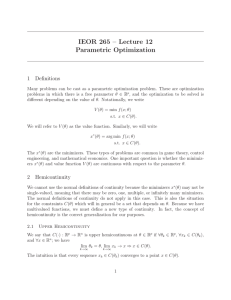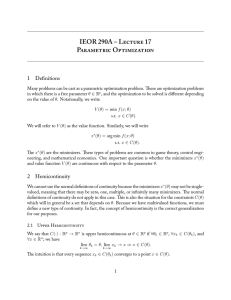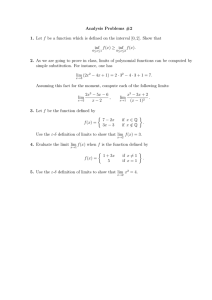IEOR 265 – Lecture 11 Parametric Optimization 1 Extended-Real-Valued Functions
advertisement
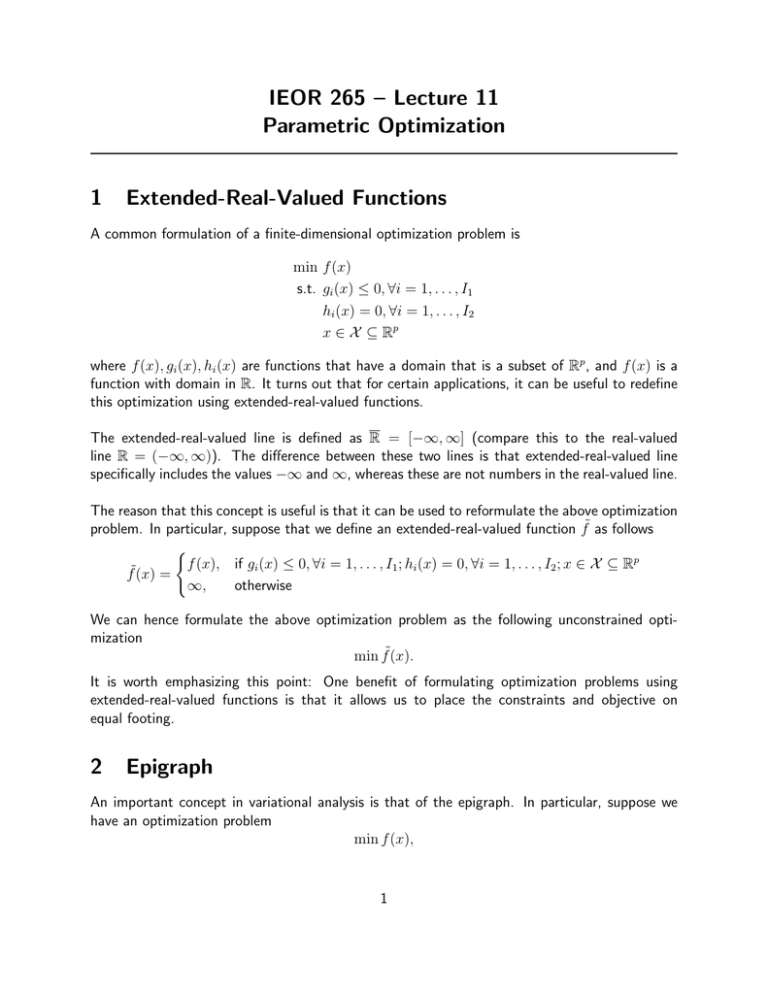
IEOR 265 – Lecture 11
Parametric Optimization
1
Extended-Real-Valued Functions
A common formulation of a finite-dimensional optimization problem is
min f (x)
s.t. gi (x) ≤ 0, ∀i = 1, . . . , I1
hi (x) = 0, ∀i = 1, . . . , I2
x ∈ X ⊆ Rp
where f (x), gi (x), hi (x) are functions that have a domain that is a subset of Rp , and f (x) is a
function with domain in R. It turns out that for certain applications, it can be useful to redefine
this optimization using extended-real-valued functions.
The extended-real-valued line is defined as R = [−∞, ∞] (compare this to the real-valued
line R = (−∞, ∞)). The difference between these two lines is that extended-real-valued line
specifically includes the values −∞ and ∞, whereas these are not numbers in the real-valued line.
The reason that this concept is useful is that it can be used to reformulate the above optimization
problem. In particular, suppose that we define an extended-real-valued function f˜ as follows
(
f (x), if gi (x) ≤ 0, ∀i = 1, . . . , I1 ; hi (x) = 0, ∀i = 1, . . . , I2 ; x ∈ X ⊆ Rp
f˜(x) =
∞,
otherwise
We can hence formulate the above optimization problem as the following unconstrained optimization
min f˜(x).
It is worth emphasizing this point: One benefit of formulating optimization problems using
extended-real-valued functions is that it allows us to place the constraints and objective on
equal footing.
2
Epigraph
An important concept in variational analysis is that of the epigraph. In particular, suppose we
have an optimization problem
min f (x),
1
where f : Rp → R is an extended-real-valued function. We define the epigraph of f to be the
set
epi f = {(x, α) ∈ Rp × R | α ≥ f (x)}.
Note that the epigraph of f is a subset of Rp ×R (which does not include the extended-real-valued
line).
3
Lower Semicontinuity
We define the lower limit of a function f : Rp → R at x to be the value in R defined by
lim inf f (x) = lim
inf f (x) = sup
inf f (x) ,
x→x
δ&0
x∈B(x,δ)
δ>0
x∈B(x,δ)
where B(x, δ) is a ball centered at x with radius δ. Similarly, we define the upper limit of f at
x as
"
#
"
#
lim sup f (x) = lim
x→x
δ&0
sup f (x) = inf
δ>0
x∈B(x,δ)
sup f (x) .
x∈B(x,δ)
We say that the function f : Rp → R is lower semicontinuous (lsc) at x if
lim inf f (x) ≥ f (x), or equivalently lim inf f (x) = f (x).
x→x
x→x
Furthermore, this function is lower semicontinuous on Rp if the above condition holds for every
x ∈ Rp . There are some useful characterizations of lower semicontinuity:
• the epigraph set epi f is closed in Rp × R;
• the level sets of type lev≤a f are all closed in Rp .
One reason that lower semicontinuity is important is that if f is lsc, level-bounded (meaning the
level sets lev≤a f are bounded), and proper (meaning that the preimage of every compact set is
compact), then the value inf f is finite and the set arg min f is nonempty and compact. This
means that we can replace inf f by min f in this case.
4
Definitions
Many problems can be cast as a parametric optimization problem. These are optimization problems in which there is a free parameter θ ∈ Rp , and the optimization to be solved is different
depending on the value of θ. Notationally, we write
V (θ) = min f (x; θ)
s.t. x ∈ C(θ).
2
We will refer to V (θ) as the value function. Similarly, we will write
x∗ (θ) = arg min f (x; θ)
s.t. x ∈ C(θ).
The x∗ (θ) are the minimizers. These types of problems are common in game theory, control
engineering, and mathematical economics. One important question is whether the minimizers
x∗ (θ) and value function V (θ) are continuous with respect to the parameter θ.
5
Hemicontinuity
We cannot use the normal definitions of continuity because the minimizers x∗ (θ) may not be
single-valued, meaning that there may be zero, one, multiple, or infinitely many minimizers. The
normal definitions of continuity do not apply in this case. This is also the situation for the
constraints C(θ) which will in general be a set that depends on θ. Because we have multivalued
functions, we must define a new type of continuity. In fact, the concept of hemicontinuity is the
correct generalization for our purposes.
5.1
Upper Hemicontinuity
We say that C(·) : Rp → Rn is upper hemicontinuous at θ ∈ Rp if ∀θk ∈ Rp , ∀xk ∈ C(θk ), and
∀x ∈ Rn ; we have
lim θk = θ, lim xk → x ⇒ x ∈ C(θ).
k→∞
k→∞
The intuition is that every sequence xk ∈ C(θk ) converges to a point x ∈ C(θ).
5.2
Lower Hemicontinuity
We say that C(·) : Rp → Rn is lower hemicontinuous at θ ∈ Rp if ∀θk ∈ Rp such that θk → θ,
∀x ∈ C(θ), there exists a subsequence θkj and xk ∈ C(θkj ) such that xk → x. The intuition is
that for every point x ∈ C(θ) there is a sequence xk ∈ C(θk ) that converges to the point.
5.3
Examples
There are two important examples of constraint sets for which C(θ) is both upper and lower
hemicontinuous. The first example is when the constraint set is independent of θ. The second
example is when the constraint set is linear in both x and θ.
6
Berge Maximum Theorem
The Berge Maximum Theorem provides an interesting set of conditions for when the minimizers
and value function are appropriately continuous. The reason for stating appropriately continuous
3
is that the function C(θ) is not a function in the normal sense; it is a multivalued function, and
so continuity has to be redefined as above. The intuition of the theorem is that if the objective is
continuous in the usual way, and the constraint set is continuous in an appropriate way, then the
value function is continuous and the minimizer is continuous in an appropriate way. More formally:
If f (x; θ) is jointly continuous in x, θ and C(θ) is compact-valued, lower hemicontinuous, and
upper hemicontinuous, then the value function V (θ) is continuous and the minimizer x∗ (θ) is
nonempty, compact-valued, and upper hemicontinuous.
There is an important note: Upper hemicontinuity at a point that is single-valued means that
the function is continuous (in the traditional sense) at that point. As a result, if the minimizer
x∗ (θ) is single-valued, then the function is continuous at x∗ (θ).
6.1
Variants
If the objective f (x, θ) is convex in (x, θ) and the graph of C(θ) (meaning the set {(x, θ) :
x ∈ C(θ)}) is convex, then the value function V (θ) is convex. Furthermore, if f (x, θ) is strictly
convex in (x, θ) and the graph of C(θ) is convex, then the value function V (θ) is convex and the
minimizer x∗ (θ) is single-valued and continuous in θ. Note that in general for both situations,
x∗ (θ) will not be convex in θ.
7
Further Details
More details about these variational analysis concepts can be found in the book Variational
Analysis by Rockafellar and Wets, from which the above material is found.
4
